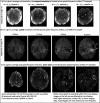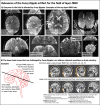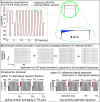This is a preprint.
Fuzzy ripple artifact in high resolution fMRI: identification, cause, and mitigation
- PMID: 39314458
- PMCID: PMC11418939
- DOI: 10.1101/2024.09.04.611294
Fuzzy ripple artifact in high resolution fMRI: identification, cause, and mitigation
Update in
-
Short-term gradient imperfections in high-resolution EPI lead to Fuzzy Ripple artifacts.Magn Reson Med. 2025 Aug;94(2):571-587. doi: 10.1002/mrm.30489. Epub 2025 Apr 2. Magn Reson Med. 2025. PMID: 40173320 Free PMC article.
Abstract
Purpose: High resolution fMRI is a rapidly growing research field focused on capturing functional signal changes across cortical layers. However, the data acquisition is limited by low spatial frequency EPI artifacts; termed here as Fuzzy Ripples. These artifacts limit the practical applicability of acquisition protocols with higher spatial resolution, faster acquisition speed, and they challenge imaging in lower brain areas.
Methods: We characterize Fuzzy Ripple artifacts across commonly used sequences and distinguish them from conventional EPI Nyquist ghosts, off-resonance effects, and GRAPPA artifacts. To investigate their origin, we employ dual polarity readouts.
Results: Our findings indicate that Fuzzy Ripples are primarily caused by readout-specific imperfections in k-space trajectories, which can be exacerbated by inductive coupling between third-order shims and readout gradients. We also find that these artifacts can be mitigated through complex-valued averaging of dual polarity EPI or by disconnecting the third-order shim coils.
Conclusion: The proposed mitigation strategies allow overcoming current limitations in layer-fMRI protocols: (1)Achieving resolutions beyond 0.8mm is feasible, and even at 3T, we achieved 0.53mm voxel functional connectivity mapping.(2)Sub-millimeter sampling acceleration can be increased to allow sub-second TRs and laminar whole brain protocols with up to GRAPPA 8.(3)Sub-millimeter fMRI is achievable in lower brain areas, including the cerebellum.
Keywords: 7T acquisition; fuzzy ripples; layer-fMRI; ventral brain.
Conflict of interest statement
Conflict of interest: Omer Faruk Gulban is an employee of Brain Innovation (Maastricht, NL). The work presented here may be partly specific to industrial design choices of SIEMENS Healthineers’ UHF scanners. This vendor is used in 83% of all human layer-fMRI papers (source: www.layerfmri.com/papers).
Figures








Similar articles
-
Short-term gradient imperfections in high-resolution EPI lead to Fuzzy Ripple artifacts.Magn Reson Med. 2025 Aug;94(2):571-587. doi: 10.1002/mrm.30489. Epub 2025 Apr 2. Magn Reson Med. 2025. PMID: 40173320 Free PMC article.
-
Short-Term Memory Impairment.2024 Jun 8. In: StatPearls [Internet]. Treasure Island (FL): StatPearls Publishing; 2025 Jan–. 2024 Jun 8. In: StatPearls [Internet]. Treasure Island (FL): StatPearls Publishing; 2025 Jan–. PMID: 31424720 Free Books & Documents.
-
Sexual Harassment and Prevention Training.2024 Mar 29. In: StatPearls [Internet]. Treasure Island (FL): StatPearls Publishing; 2025 Jan–. 2024 Mar 29. In: StatPearls [Internet]. Treasure Island (FL): StatPearls Publishing; 2025 Jan–. PMID: 36508513 Free Books & Documents.
-
Signs and symptoms to determine if a patient presenting in primary care or hospital outpatient settings has COVID-19.Cochrane Database Syst Rev. 2022 May 20;5(5):CD013665. doi: 10.1002/14651858.CD013665.pub3. Cochrane Database Syst Rev. 2022. PMID: 35593186 Free PMC article.
-
How lived experiences of illness trajectories, burdens of treatment, and social inequalities shape service user and caregiver participation in health and social care: a theory-informed qualitative evidence synthesis.Health Soc Care Deliv Res. 2025 Jun;13(24):1-120. doi: 10.3310/HGTQ8159. Health Soc Care Deliv Res. 2025. PMID: 40548558
References
-
- Heid Oliver. Method for the phase correction of nuclear magnetic resonance signals, Patent: US006043651A 2000.
-
- Feiweier T, inventor; Siemens Aktiengesellschaft, assignee. Magnetic resonance method and apparatus to determine phase correction parameters. US Patent 8,497,681. July 30, 2013.
Publication types
Grants and funding
LinkOut - more resources
Full Text Sources
